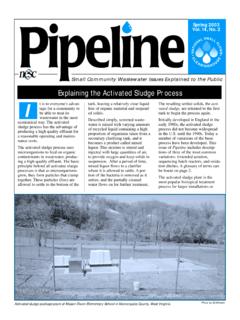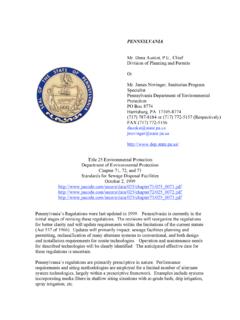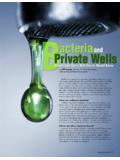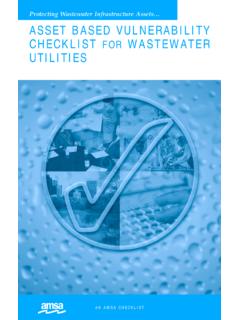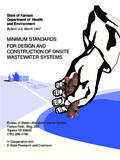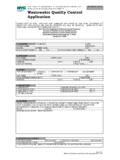Transcription of PL Winter Fall 97 - National Environmental Services …
1 1 PIPELINE - fall 1997; Vol. 8, No. 4 National Small Flows Clearinghouse 1-800-624-8301 PipelineFall 1997 Vol. 8, No. 4 Small Community wastewater Issues Explained to the PublicDNATIONAL SMALL FLOWSCLEARINGHOUSEBASIC wastewater CHARACTERISTICSW astewater characteristicsare important for: National Small Flows Clearinghouse 1-800-624-8301community officials Certain wastewater components candegrade water quality and endangerpublic health (see page 3). Treatment plant workers can beharmed by hazardous substances inwastewater (see page 4). Reducing community wastewaterflows can save money (see page 5). System operators and others can beheld liable for pollution from untreatedwastewater (see page 2).homeowners Certain hazardous household sub-stances may pollute local wells anddrinking water sources (see page 4). Reducing household wastewatersaves money (see page 5). Pollution from malfunctioning onsitesystems can harm family, friends,and neighbors (see page 2).
2 Adapted from: Siegrist, R. L. l977. Waste Segregation to Facilitate Onsite wastewater Disposal Alternatives. ASAE publication and treating wastewater also arediscussed. The information can be used asan introduction to wastewater for newcommunity officials and staff or as a tool toeducate homeowners and the general public. Readers are encouraged to reprintPipeline articles in local newspapers orinclude them in flyers or educationalpresentations. Please include the name andphone number of the National Small FlowsClearinghouse (NSFC) on the reprintedinformation and send us a copy for our you have any questions about reprint-ing articles or about any of the informationin this newsletter, please contact the NSFCat (800) 624-8301 or (304) 293-4191. o you know what happens toyour wastewater after you takea shower, wash dishes, or flushthe toilet? Where exactly doesit go? What is in it? How does it affect theenvironment?
3 And why should you care?If you are like most people, you nevergive much thought to what happens to thewastewater from your home and commu-nity. But whether you think about it muchor not, wastewater continues to affect yourlife even after it disappears down the wastewater Affects YouThe water we use never really goesaway. In fact, there never will be any more orany less water on Earth than there is rightnow, which means that all of the wastewa-ter generated by our communities eachday from homes, farms, businesses, andfactories eventually returns to the environ-ment to be used again. So, when wastewa-ter receives inadequate treatment, the overallquality of the world s water supply , the amount of wastewater homesand communities produce, its characteristics,and how it is handled can greatly impactresidents quality of life. wastewater has thepotential to affect public health, the localeconomy, recreation, residential and businessdevelopment, utility bills, taxes, and otheraspects of everyday small community residents, inparticular, are more likely to be directlyresponsible for making decisions about theirwastewater, it is important that they knowsomething about its characteristics (that is,its components, strength, volume, and flow)and how certain characteristics can affecttheir issue of Pipeline answers some basicquestions about wastewater characteristicsand their potential impact on public healthand the environment.
4 Some methods forHousehold Wastewater2 PIPELINE - fall 1997; Vol. 8, No. 4 National Small Flows Clearinghouse 1-800-624-83012 wastewater BASICSWhat is wastewater ? wastewater is sewage, stormwater, andwater that has been used for various pur-poses around the community. Unlessproperly treated, wastewater can harmpublic health and the communities generate wastewaterfrom both residential and WastewaterAlthough the word sewage usually bringstoilets to mind, it actually is used to describeall types of wastewater generated fromevery room in a the , sewage varies regionally andfrom home to home based on such factorsas the number and type of water-usingfixtures and appliances, the number ofoccupants, their ages, and even their habits,such as the types of foods they eat. However,when compared to the variety of wastewa-ter flows generated by different nonresi-dential sources, household wastewatershares many similar characteristics are two types of domestic sewage.
5 Blackwater wastewater from toilets, and graywater wastewater from all sourcesexcept of blackwater and graywater areillustrated on page and graywater have differentcharacteristics, but both contain pollutantsand disease-causing agents that , some areas in the permitthe use of innovative systems that safelyrecycle household graywater for reuse intoilets or for irrigation to conserve waterand reduce the flow to treatment the article on page 6 and the list ofresources on page 8 for more about waterconservation methods and graywater WastewaterNonresidential wastewater in smallcommunities is generated by such diversesources as offices, businesses, departmentstores, restaurants, schools, hospitals,farms, manufacturers, and other commer-cial, industrial, and institutional is a nonresidential source andcarries trash and other pollutants fromstreets, as well as pesticides and fertilizersfrom yards and of the variety of nonresidentialwastewater characteristics, communitiesneed to assess each source individually orcompare similar types of nonresidentialsources to ensure that adequate treatmentis example, public restrooms maygenerate wastewater with some character-istics similar to sewage, but usually athigher volumes and at different peak volume and pattern of wastewater flowsfrom rental properties, hotels, and recrea-tion areas often vary seasonally as differ from many othernonresidential sources because theyproduce high volumes of wastewatercontaining lint fibers.
6 Restaurants typicallygenerate a lot of oil and grease. It may benecessary to provide pretreatment of oiland grease from restaurants or to collect itprior to treatment, for example, by addinggrease traps to septic from some nonresidentialsources also may require additionaltreatment steps. For example, stormwatershould be collected separately to preventthe flooding of treatment plants during wetweather. Trash and other large solids fromstorm sewers often are removed by screens. In addition, many industries producewastewater high in chemical and biologicalpollutants that can overburden onsite andcommunity systems. Dairy farms andbreweries are good examples communi-ties may require these types of nonresiden-tial sources to provide their own treatmentor preliminary treatment to protectcommunity systems and public about nonresidential waste-water is available through National SmallFlows Clearinghouse (NSFC) resources,some of which are listed on page the NSFC for more details.
7 That wastewater treatment is a relativelyrecent practice? Prior to the mid 1800s,human and other wastes usually were justdumped or conveyed to the nearest body ofwater without a result, groundwater and othersources for drinking and bathing wereregularly contaminated with of cholera, typhoid, dysentery,and other waterborne diseases killedthousands, and outbreaks were especiallydevastating in densely populated 1854, when the connection betweena cholera outbreak and sewage-contami-nated water was first discovered, betterattempts were made to treat and dispose ofsewage separately from drinking , until the latter part of thiscentury, many communities stillallowed discharges of untreated orinadequately treated wastewater fromhomes, industries, and combined storm andsanitary sewers. Treatment standards oftenvaried from town to town, and as populationgrew, damage to the environment and risksto public health were reaching dangerouslevels in the 1970s, Congress passedlegislation that led to the establishment ofnational water quality standards and limitsfor the discharge of pollutants.
8 Recentamendments to the Clean Water Act havetransferred implementation of pollutioncontrol to individual state , community leaders are responsiblefor ensuring that state standards for waste-water treatment and water quality are metconsistently not only at inspection time,but always to protect public health and theenvironment. In some cases, treatmentplant operators and community leaders maybe held personally liable for also are personally liable formalfunctioning onsite systems. Onsitesystems must be properly operated andmaintained to protect groundwater andother drinking watersources, as well asthe health of familyand neighbors. Did You Know ..3 PIPELINE - fall 1997; Vol. 8, No. 4 National Small Flows Clearinghouse 1-800-624-8301 wastewater BASICSW astewater is mostly water by materials make up only a smallportion of wastewater , but can be presentin large enough quantities to endangerpublic health and the practically anything that canbe flushed down a toilet, drain, or sewercan be found in wastewater , even house-hold sewage contains many wastewater components that shouldbe of most concern to homeowners andcommunities are those that have thepotential to cause disease or detrimentalenvironmental different typesof organisms live in wastewaterand some are essential contributors totreatment.
9 A variety of bacteria, protozoa,and worms work to break down certaincarbon-based (organic) pollutants inwastewater by consuming them. Throughthis process, organisms turn wastes intocarbon dioxide, water, or new cell and other microorganisms areparticularly plentiful in wastewater andaccomplish most of the treatment. Mostwastewater treatment systems are designedto rely in large part on biological disease-causing viruses, parasites,and bacteria also are present in wastewaterand enter from almost anywhere in thecommunity. These pathogens oftenoriginate from people and animals who areinfected with or are carriers of a example, graywater and blackwaterfrom typical homes contain enoughpathogens to pose a risk to public likely sources in communitiesinclude hospitals, schools, farms, and foodprocessing illnesses from wastewater -relatedsources are relatively common. Gastroen-teritis can result from a variety ofpathogens in wastewater , and cases ofillnesses caused by the parasitic protozoaGiardia lambia and Cryptosporidium arenot unusual in the Other importantwastewater-related diseases includehepatitis A, typhoid, polio, cholera, anddysentery.
10 Outbreaks of these diseases canoccur as a result of drinking water fromwells polluted by wastewater , eatingcontaminated fish, or recreational activitiesin polluted waters. Some illnesses can bespread by animals and insects that come incontact with municipal drinking water sourcesare not completely immune to health risksfrom wastewater pathogens. Drinkingwater treatment efforts can become over-whelmed when water resources are heavilypolluted by wastewater . For this reason, wastewater treatment is as important topublic health as drinking water a detailed discussion of the healthrisks associated with wastewater , refer tothe Summer 1996 (vol. 7, no. 3) Pipeline,Item # MatterOrganic materials are found everywherein the environment. They are composed ofthe carbon-based chemicals that are thebuilding blocks of most living materials in wastewater originatefrom plants, animals, or synthetic organiccompounds, and enter wastewater inhuman wastes, paper products, detergents,cosmetics, foods, and from agricultural,commercial, and industrial compounds normally are somecombination of carbon, hydrogen, oxygen,nitrogen, and other elements.


